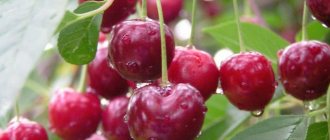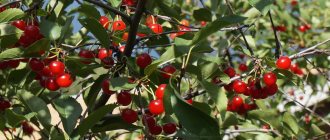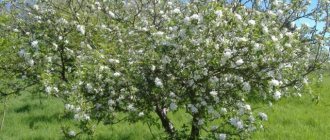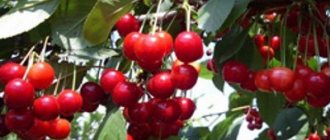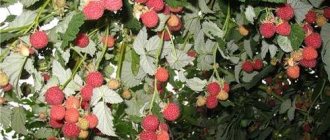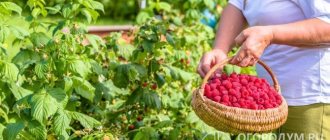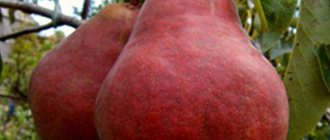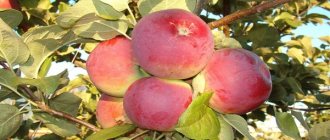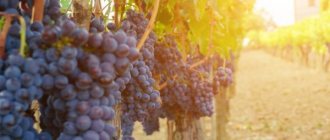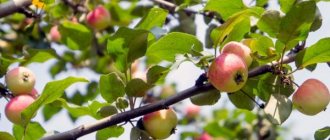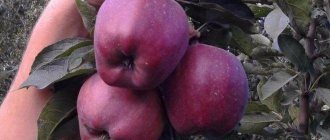Description of Apukhtinskaya cherry
Next, a description of the Apukhtinskaya cherry will be presented, its photos will be shown, pollinators will be listed, and reviews from gardeners about growing this variety will be given. The material is for informational purposes only. More complete information about Apukhtinskaya cherry can be found in specialized literature.
Folk selection variety - Apukhtinskaya cherry
The Tula region, the village of Apukhtino, is considered the birthplace of the Apukhtinskaya cherry. The parental forms of this variety are unknown. According to some reports, the Apukhtinskaya cherry is related to the Morel lotova, although this cannot be stated unequivocally. There is no information on this variety in the State Register. The plant is characterized by good winter hardiness and ease of care. It grows well in central Russia and can also be cultivated in more northern regions.
The Apukhtinskaya cherry variety, a photo and description of which is given in this article, in appearance is more reminiscent of shrub varieties with well-developed skeletal shoots. The stem is short and well developed. The crown is drooping and sparse.
A short video review of this variety can be viewed at the link:
https://www.youtube.com/watch?v=7yN_6C6MA_A
Height and dimensions of an adult tree
An adult Apukhtinskaya cherry tree does not grow higher than 3 m. This is very convenient when working with it. The crown is rounded, its diameter is 2-2.5 m. The shoots are quite thin, becoming bare as the tree ages.
Description of fruits
Apukhtinskaya cherry berries ripen quite late, in August. These are drupes weighing 3-3.5 g, dark red, rounded-flattened in shape, with a wide central funnel. The skin of the fruit is thin and glossy. The pulp is juicy, ruby red, medium density. The taste is bright, sweet and sour, classic cherry. The stone is single, oval, quite large, easily separated from the pulp. The stalk is long, thin, and firmly attached to the fruit.
The berries of the Apukhtinskaya cherry are quite large
The separation is semi-dry. The variety is not prone to shedding, since ripening occurs gradually. Due to late ripening, the berries do not bake in the sun.
Pollinators of the Apukhtinskaya cherry
Apukhtinskaya cherry is a self-fertile variety. Due to the structural features of the flower, pollination can occur even without opening. However, for maximum yield, it is still advisable to plant pollinators nearby. Apukhtinskaya cherry blossoms quite late, in June, which makes it quite difficult to choose a pollinator variety for it according to the description. The vast majority of other varieties bloom much earlier. Gorkovskaya, Zhuravka, Lotovaya, Lyubskaya, Malinovka, Shchedraya can be suitable as a pollinator for the Apukhtinskaya cherry.
All of these varieties bloom and ripen at approximately the same time as the Apukhtinskaya cherry, so they can be used to cross-pollinate each other.
Features of a garden in the Moscow region
The main problem of gardeners in the Moscow region is winter with winds and frosts. Therefore, trees can only be planted here with increased frost resistance and winter hardiness.
Attention! Frost resistance is the ability of a plant to withstand temperatures below -35°C. Winter hardiness is the ability of a plant to tolerate frosts, strong winds, icing and other climatic manifestations of winter.
For a cherry variety that will be planted in the Moscow region, it is very important to resist fungi such as moniliosis and coccomycosis. They are very common in this region, and the fight against them is carried out exclusively with pesticides.
Attention! If a cherry tree is infected with fungi, its fruits most often cannot be eaten.
Main characteristics
Apukhtinskaya cherries have long been successfully grown in many regions of Russia. Such long-term popularity is associated with the resistance of this variety to various adverse factors, ease of care and stable annual yield.
Drought resistance, frost resistance
The winter hardiness of the Apukhtinskaya cherry is not very high; it is believed that it can easily tolerate temperature drops down to -20 °C. This is pretty average. In severe frosts, the shoots may freeze slightly, but in the summer they quickly recover. Apukhtinskaya cherry also tolerates long-term drought well. However, in the first two years, until the fruit-bearing tree has fully formed, the soil should not be allowed to dry out.
Productivity
Apukhtinskaya cherry belongs to the early-fruiting varieties. After planting, seedlings produce their first harvest in the 2nd or 3rd year, and after grafting - the next year after the procedure. Every year the number of fruits increases, and by the 5th year the cherry can bear up to 10 kg of berries. Fruiting of the Apukhtinskaya cherry is annual and stable; with good care and favorable weather conditions, the yield from 1 tree can reach up to 15-20 kg.
Under good conditions, Apukhtinskaya cherries invariably produce good harvests
The purpose of the fruit is technical. Apukhtinskaya cherry berries are excellent for processing into preserves, jams, and compotes. They can also be consumed fresh, however, the well-perceived sourness and sometimes bitterness in the taste is perceived negatively by many. It is advisable to put the berries into processing as soon as possible, since the shelf life and transportability of Apukhtinskaya cherries is not very high.
Advantages and disadvantages
Experts and gardeners unanimously note the following advantages of Apukhtinskaya cherries:
- Precociousness.
- Annual fruiting.
- Late flowering, so flowers are not damaged by return frosts.
- Self-fertility.
- Resistance to major diseases.
- Reluctance to shed berries.
Apukhtinskaya cherry is not without its drawbacks. The following indicators are considered the main negative aspects of this variety:
- Mediocre taste of fruits and their technical purpose.
- Low keeping quality and transportability of berries.
- Tree susceptibility to coccomycosis.
Despite the existing shortcomings, the Apukhtinskaya cherry variety remains popular among gardeners, and this is largely due to the plant’s resistance to the vagaries of the weather and its low maintenance requirements.
Characteristics of the tree and fruits
This data will help you choose the right place for landing and take into account all the necessary nuances. Studying the characteristics makes it possible to avoid mistakes when growing:
- tree height 2.5-3 m;
- looks like a bush;
- drooping branches;
- the color of the flowers is white;
- ripens in August.
The fruits do not fall from the tree, so gradual ripening does not interfere with one-time harvesting. The fruits are heart-shaped, glossy, thin skin. The color of the berries is deep red. Cherries weigh on average 4 g and taste sour. But this does not prevent you from consuming them fresh. In addition, the fruits from this tree are excellent for preparing winter preparations, drying and freezing.
Characteristics of the felt cherry variety Natalie, description of yield and disease resistanceRead
Landing rules
The average lifespan of a cherry tree is 20 years. It is undesirable to transplant it to another place, so before planting the seedling you need to correctly assess the situation and choose a suitable place. High-quality planting material is of great importance. The Apukhtinskaya cherry seedling should have a healthy appearance, good roots with lateral branches, and there should be no mechanical damage.
It is better to purchase Apukhtinskaya cherry seedlings from ZKS
Important! Seedlings that are 2 years old are optimal for planting.
Recommended timing
Cherry begins the growing season very early, much earlier than many other fruit plants. It should be planted in early spring, as soon as the ground thaws. In areas with a warm climate, planting Apukhtinskaya cherries can be postponed until autumn. It should be taken into account that at least 3 weeks must remain from the moment of planting until the onset of frost, so that the seedling is guaranteed to have time to take root in the new place.
Site selection and soil preparation
The best place for Apukhtinskaya cherries is the south side of a fence or low building. In this case, the seedling should not be in the shade of other buildings or tall trees; lack of sun has a negative effect on the growth and yield of berries. The mail should be loamy or sandy loam, neutral or slightly alkaline. The groundwater at the planting site must lie at a depth of at least 2 m; if it is located higher, then it is necessary to add soil.
Normal soil acidity is the key to successful cherry growing
Before planting, it is advisable to check the acidity level of the soil. Too acidic soil must be neutralized by adding lime or dolomite flour. For spring planting of Apukhtinskaya cherries, it is better to carry out all manipulations with the ground in the fall, at the same time clearing the area of debris, stones and old vegetation. Before autumn planting, it is better to prepare the site 2-3 weeks before the start of work.
How to plant correctly
Before planting Apukhtinskaya cherry seedlings, it is necessary to dig planting holes, the dimensions of which should be slightly larger than the volume of the root system. Practice shows that a depth of 0.6 m and a diameter of 0.6-0.8 m is quite sufficient. The extracted soil is mixed in equal proportions with humus, while adding a few tablespoons of superphosphate and 0.5 kg of wood ash to the nutrient soil. In spring, it is advisable to add 1-2 tbsp to the above components. l. nitroammophoska or other nitrogen fertilizer, but when planting in autumn it is better to do without it.
Before planting Apukhtinskaya cherry seedlings, you need to drive a peg into the center of the hole, which will initially become a support for the future tree. If you do this after planting, there is a high risk of damaging the roots of an already planted plant. Also, in the center of the hole, an earthen mound is poured, along the sides of which the roots of the seedling are spread. After this, the root system is gradually covered with nutrient soil. From time to time it is advisable to add water and compact the soil, this way you can reduce the likelihood of voids forming in the roots.
It is always more convenient to plant cherries together
Important! The root collar of the Apukhtinskaya cherry seedling should be flush with the ground surface.
After the planting hole is completely filled with soil, the seedling is tied to a support. A small earthen roll 8-10 cm high is poured around the stem so that the water does not spread, and then the root zone is intensively watered. Planting ends by mulching the tree trunk circle with peat or humus, this will help retain moisture in the soil longer.
Important! When planting cherries in groups, the interval between neighboring Apukhtinskaya cherry seedlings should be at least 3 m.
Features of care
Apukhtinskaya cherry is quite undemanding in terms of growing conditions, so caring for it is not difficult. It includes only such mandatory procedures for gardeners as watering, fertilizing, various types of pruning, as well as periodic treatments against diseases and pests.
Watering and fertilizing schedule
For the first 2 years after planting, watering the Apukhtinskaya cherry should be abundant and regular. In dry weather, young trees need to be watered at least once a week, pouring at least 10 liters of water under each specimen. It is better to do this in the late evening so that evaporation from the soil surface under the influence of the sun is minimal. Adult fruiting cherries are less demanding on watering, however, they also need water, especially during the period of formation and filling of berries. In dry weather, mature trees need to be watered at least once a week, and the watering rate for each plant should be 20-30 liters.
Cherries, especially when young, require regular watering.
Important! Many gardeners dig a ring groove 15-20 cm deep around the cherry trunk and periodically fill it with water. Such an irrigation system moistens the root zone more evenly, and moisture evaporation occurs much more slowly.
In the first 1-2 years after planting, there is no need to fertilize the Apukhtinskaya cherry, since during this period the fertilizers added to the soil during planting are sufficient for its development. With the beginning of active fruiting, nutrients begin to be consumed much faster, and their deficiency in the soil must be replenished in a timely manner.
Adding organic matter is an important part of caring for cherries.
Apukhtinskaya cherry is fertilized in several stages.
- Early spring, before flowering. At this time, fertilizing is done with nitrogen fertilizers (urea, ammonium nitrate). Approximately 30 g is spent on each tree. Fertilizer can be applied in dissolved form (usually they are diluted in 10 liters of water and the root zone is watered with the solution) or in dry form, evenly scattering the granules over the surface of the earth. Many gardeners scatter dry fertilizers even on the last snow; in this case, the nutrients go into the soil along with the melt water.
- At the end of the flowering period. The best feeding at this time is liquid organic matter - an infusion of chicken manure or slurry. These solutions are used to water the soil around the tree trunk.
- During fruit ripening. During this period, foliar feeding is carried out by spraying the trees with a urea solution (20 g of fertilizer per 10 liters of water).
- After fruiting. At this time, fertilizing with complex potassium-phosphorus fertilizers is carried out. You can also use organic matter, for example, humus or old rotted manure. Organic fertilizers are applied to the tree trunk when digging it in the fall.
Trimming
Pruning cherry trees helps to form a beautiful and practical tree crown, which is as convenient as possible for the gardener to work with and optimal for fruiting. In addition, some shoots are removed for preventive purposes.
Here are some types of pruning of Apukhtinskaya cherry:
- Formative. Produced to give the tree a specific shape. Depends on the gardener’s preferences and climate conditions.
- Sanitary. Carry out annually at the beginning and end of the season to clean the tree of old, diseased, broken and dry branches.
- Thinning. Produced to remove crown-thickening, improperly growing shoots, as well as to clean the trunk and root zone of unnecessary growth.
Important! Different types of pruning are usually combined to achieve maximum effect.
Preparing for winter
In the southern regions, Apukhtinskaya cherries are not covered for the winter. In more northern areas, young trees must be protected from frost. They are wrapped in a layer of breathable material and also tied with spruce branches. Barrier nets are installed around the trunks, which will protect them from hares.
Apukhtinskaya cherry seedlings must be covered for the winter
In mature trees, the trunk and lower skeletal branches should be whitewashed to a height of 1.5 m to protect against sunburn.
Self-fertile cherry varieties for the Moscow region
A plant like cherry grows in literally every garden.
And if there is no garden, then at least a couple of trees are somehow present next to the house, and sometimes even in the middle of the flowerbed. The northern regions of our country are also no exception, but not everyone can choose the best variety for the Moscow region. First of all, this is due to the peculiarities of the climatic conditions of the Moscow region, since quite often frosts in this region reach 35 degrees below zero. Before finding out what characteristics cherries that are grown in the northern regions must meet, and which ones will successfully take root here, in the typical climate of the Moscow region.
Frosty winters of the Moscow region
As mentioned above, winters in the Moscow region are quite severe, and they often experience disasters such as icing. In this regard, cherry varieties for this region must have:
- good frost resistance - needed to be able to withstand such low temperatures;
- winter hardiness - necessary to withstand sudden frosts or icing.
The most common diseases of cherries
Fruit trees, including cherries, that grow in the Moscow region are most often susceptible to diseases, the first places among which are occupied by:
- Coccomycosis. This disease of fruit trees pathologically affects the deciduous part of the plant - its leaves gradually begin to change their color, eventually they turn yellow and leave the branches.
- Moniliosis. The berries themselves are affected - a white coating begins to appear on them, after which the fruits rot and become unfit for consumption.
That is why, in the Moscow region, plants must also have increased immunity to these diseases, because trees can be protected from them only with the help of chemicals, but this will make the berries unsuitable for food and even for making jams, preserves, etc.
Having correlated all the required characteristics that the best trees should have for the specified region of our country, among them we can distinguish several species that feel comfortable in the local climate and are not predisposed to diseases:
- Apukhtinskaya cherry,
- Lyubskaya cherry,
- Youth cherry,
- Turgenevka.
Apukhtinskaya
The variety is not particularly tall , which can be less than 2.5-3 m; its shape resembles a bush.
It begins to bear fruit abundantly in the second year after planting with large dark red fruits, slightly reminiscent of hearts. The fruits have a slight bitterness. Apukhta cherry is classified as a late self-fertile tree. It blooms in mid-June, and harvesting can begin in late summer. Due to late flowering, it is quite resistant to the winter season. but at the same time, due to its immunity to winter, it is not suitable for use in cross-pollination. In addition, if autumn comes too early, which, unfortunately, happens more and more often every year, and at the same time sharp cold is pressing, then the trees may not meet the deadline, fail to ripen and fall off. But this variety is almost completely resistant to coccomycosis.
When choosing Apukhtinskaya cherries for planting in the Moscow region, you should prefer two-year-old seedlings to others. The most suitable area for a young tree is considered to be the south side of the garden, since there it will receive enough sunlight, which it needs for normal development.
It is best to plant the Alushta variety in the autumn. In this case, it is recommended to choose a place as far as possible from groundwater - preferably no closer than 2.5 m to the surface of the earth.
This variety can quite possibly be considered one of the best for the Moscow region, because it is completely undemanding to care. It is advisable to trim and fertilize the tree in a timely manner. The first fertilizing is done during planting (potassium, superphosphates and organic fertilizers). The next feedings are carried out every three years. When pruning this tree, it is necessary to leave only 5 shoots to form a crown. The first pruning is carried out immediately after planting in the ground. after that, every autumn the crown is simply thinned out a little to obtain a bountiful harvest and maintain shape.
As for the timing and amount of watering , it is imperative to carry it out only once when planting a seedling. and subsequent ones are carried out only in dry times. The rest of the time, this tree will have enough natural precipitation.
Lyubskaya
One of the main advantages of this variety is its small height , to which it grows upon reaching adulthood.
The tree does not rise more than 3 meters, which greatly facilitates the harvesting process. It is also important that Lyubskaya, when growing up, forms a crown of moderate density, although quite spreading. This greatly simplifies the care of this variety during pruning. Its side branches are formed in the form of an arc and are located at an acute angle to the main trunk. The bark is brown with a gray tint, and the surface of the Lyubskaya bark itself is covered with characteristic cracks.
Its fruits have an attractive, beautiful deep red color . The taste characteristics of this variety are dominated by sour taste. In this regard, Lyubsk cherries are mainly used for preparing compotes, preserves and jams, where the sour note can be smoothed out by adding sugar.
The Lyubsky variety is considered self-fertile; it is even capable of bearing fruit alone. Harvesting is possible already from the second year after planting the tree, and upon reaching two years of age, this fruit tree comes into full strength and begins to bear fruit as abundantly as possible. Its fruits are usually resistant to transportation. Moreover, after twenty years, its life cycle ends, the tree is depleted and there is no more harvest to be expected.
Disadvantages include the peculiarities of its bark . Due to the fact that it has deep cracks. Through them, during severe frosts, the tree can get burned. In this regard, the trunk and also the roots require additional shelter.
In the process of growing Lyubsk cherry on soils with an acidic reaction, before starting to plant a seedling, you should lime the soil, because this variety has difficulty growing at elevated acidity levels.
In addition, the Lyubsk tree reacts negatively to regular chemical fertilizing . but at the same time she gratefully accepts feeding rich in organic matter. The Lyubsky variety is completely unpretentious in care, does not require pruning, except for the need to sometimes remove dry shoots and abundant watering (watering must be carried out in moderation and not too often to avoid stagnation of moisture near the root system).
Youth
This variety was obtained as a result of hybridization, in which two varieties took part - Lyubskaya and Vladimirskaya.
Young cherry can grow both in the form of a tree and as a shrub. The tree reaches a maximum height of 2.5 meters, and the harvest can begin to be harvested in late July. The fruits of this variety have a rich red color, they have juicy pulp, and in terms of taste they have a sweet and sour taste. Youth variety cherries are most often consumed fresh, but they are also excellent in canning.
The tree bears fruit every year and is very abundant and withstands winter cold and severe frosts. The flower buds of this variety are not particularly resistant to spring frosts. In addition, with a fairly humid summer, which is also accompanied by high air temperatures, they are quite often susceptible to fungal diseases.
To start growing cherries of this variety, you must first carefully select a well-lit place . It is advisable to ensure that it is located on a hill. Youth variety cherries prefer neutral sandy soil and a moderate watering regime, and also require pruning to form a crown and removal of dried branches. Young seedlings need additional shelter with the onset of winter.
Turgenevka
Turgenevskaya cherry was obtained thanks to the Zhukovskaya variety.
Turgenev cherry is a short tree, rarely growing above three meters. Its crown resembles an inverted pyramid. The berries begin to ripen at the beginning of July. If the summer turns out to be warm and at the same time with a good level of precipitation, then its juicy cherries are almost completely free of acidity. The Turgenev variety is distinguished by such an indicator as low self-fertility, and therefore the proximity of pollinating varieties is necessary for the appearance of a harvest. The best option in this case is Lyubskaya cherry.
Turgenev cherry is rightfully considered the best variety for the Moscow region . Turgenevka winters well in severe frosts and has strong immunity to various diseases. In addition, the variety is distinguished by its high level of productivity, and its large fruits are easily transported.
When caring for Turgenev cherry, you should pay due attention to the following points:
- Avoid low areas during planting.
- Prune the tree annually, paying special attention to the lower branches of the tree to thin out the crown.
- During fruit ripening, additional watering is necessary.
- Cover trees for the winter to protect them from pests.
When choosing Turgenevka cherries for planting in the Moscow region, you must take into account the fact that they begin to bear fruit only 5 years after planting, and the buds of future flowers are very afraid of spring frosts.
Diseases and pests
Apukhtinskaya cherry has good immunity to diseases. However, diseases can still appear, especially in weakened and aged specimens. Below are some of them.
Coccomycosis, Apukhtinskaya cherry is prone to this particular fungal disease. It can be recognized by multiple reddish-brown small round spots that begin to cover the leaves of the tree in abundance.
As the disease progresses, it begins to affect not only the leaves, but also the fruits, causing the loss of a significant part of the harvest. The disease greatly reduces the winter hardiness of cherries and can lead to its death in winter. Prevention is the timely removal of plant debris, sanitary pruning, as well as whitewashing the trunks and treating the tree with fungicides (Bordeaux mixture).
Moniliosis is a fungal disease, especially noticeable on annual growth. On diseased shoots, leaves begin to curl and turn brown, and flowers or berries begin to dry out. If you cut an infected branch, you will notice the presence of black rings on the cut.
Treatment and prevention of moniliosis consists of timely treatment of cherries with fungicides, Fitosporin or Fitolavin, as well as maintaining the cleanliness of the bush and the tree trunk.
Scab, the disease usually manifests itself in regions with warm climates. Scab-affected leaves curl, turn yellow and dry out, and the fruits dry out or crack. The disease cannot destroy the tree, but its yield can suffer quite severely.
To prevent and treat scab, cherries are treated with Bordeaux mixture several times during the season. Affected leaves and shoots should be cut off and burned. The trunk of the cherry tree must be whitened, and fallen leaves and affected shoots must be removed and burned in a timely manner.
No less dangerous for the Apukhtinskaya cherry are various insect pests that spoil both the tree itself and the harvest of berries. Here are some of them:
- Aphids are microscopic insects found in large numbers on many garden crops. Large colonies of aphids suck the juice from the leaves, which greatly harms plants and young shoots. You can scare away aphids from cherries if you plant some types of plants next to the trees: fennel, thyme, dill. The pest cannot tolerate their pungent odor. To kill insects, trees are sprayed with various insecticides: Iskra, Inta-Vir. A good result is achieved by using an infusion of ash, garlic, celandine or tansy for this purpose.
- Ants. These insects appear on cherries along with aphids, which they themselves spread. Hunting belts, various mechanical obstacles, and special chemicals are used against ants.
